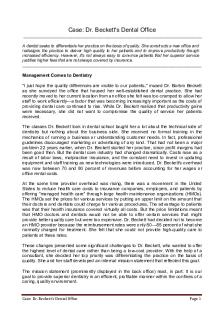Bioremediation Case Study - Dr Louglin PDF

| Title | Bioremediation Case Study - Dr Louglin |
|---|---|
| Author | Ella Dobbin |
| Course | Biological Sciences |
| Institution | Nottingham Trent University |
| Pages | 3 |
| File Size | 170.8 KB |
| File Type | |
| Total Downloads | 35 |
| Total Views | 158 |
Summary
Lecture Summary for Bioremediation Case Study (Dr Loughlin, Applied Microbiology '15/16)...
Description
Dr. Loughlin
Bioremediation Case Study: Oil Spillage
Petroleum hydrocarbons: low MW gases, higher MW liquids and soilds at RT o Saturates o Aromatics o Asphaltene: phenols, fatty acids, ketones, esters & porphyrins o Resins: pyrimidines, quinolones, sulphoxides, amides Oil bioremediation o Petroleum hydrocarbons = rich source of organic matter o Most susceptible: N alkalines Low MW aromatics o Harder to degrade: Branched alkanes Polycyclic aromatics Biochemistry of petroleum degradation: o Aromatic hydrocarbons o Pseudomonas bacteria o Degradation usually requires oxygenase enzymes which add oxygen to the aromatic ring So reactions require oxygen Genes encoding oxygenase enzymes are often on plasmids o Aliphatic hydrocarbon: Used as electron donors (like glucose and other sugars) Can also occur by carboxylation Addition of CO2 under anoxic conditions to make a fatty acid Fatty acid then oxidised by B-oxidation to acetyl Co-A Ring structures tougher o Oxygenases: Add O from O2 to an aromatic ring o Mono-oxygenase: Add one O, the other is reduced to H2O
o DI-oxygenase: Both O from O2 added to the ring
Dr. Loughlin o Sequential Dioxygenase:
o End products such as catechol can be incorporated into metabolism and transformed to succinate, acetyl Co-A or pyruvate o Eventually, hydrocarbons are oxidised to CO2 Oil Bioremediation: o Oil state: Oil spill on soil or into sediment from water Vertical movement………………… through soil Prevents ……………………. losses (no loss of C12 compounds) o Toxic hydrocarbons: Toxic to hydrocarbon degrading bacteria Slower bioremediation… lower ………..levels Bacteria with oxygenase enzymes may be unable to bioremediate without O2 So bacteria not present Effects of an oil spill: o Fish Toxicity o Sea birds o Sea mammals o Plankton o Shorelines o Invertebrates Oil is insoluble and less dense than water floats on water Wave action plenty of oxygen Oil in water or water in oil emulsion Non-bioremediation methods: o Physical containment o Burning o Dispersant o Water jets (shoreline) Oil Bioremediation: o Microbial biosurfactants: Peptides, lipids, saccharides Amphipathic with MW typically 500-1500 Da Reduce surface tension Increase surface area for attack 96% of hydrocarbon producing bacteria o Artificial Surfactants Must be environmentally friendly
Dr. Loughlin
Torrey Canyon disaster, Cornwall 1967 No longer use napalm and toxic detergents o Supplementing natural population with GM Bacteria Key enzymes (oxygenases) Known organisms added to environment But concern over uncontrolled release of GMOs o Optimising environmental conditions Maximise indigenous degrading microbes (already have oxygenases) Fertiliser addition (P, N often limiting in marine envt) Nitrogen fertilisers used extensively in Exxon Valdez incident Dispersants to increase amount of hydrocarbon-water interface Comparing Exxon Valdez & Deepwater: o Deepwater 10X more oil spilled, plus methane, from 1500 m underwater. Light crude so more easily degraded. o Gulf of Mexico open and exposed, many natural oil seeps and other drilling rig spills. Spill was 77 km offshore. o Exxon Valdez surface water slick, near shore, heavy crude o Alaskan site pristine, shallow and enclosed. Spill close to shore. o So treatments used were very different o BP Deepwater Horizon = largest ever remediation & emergency response to an oil spill worldwide...
Similar Free PDFs

Dr Pepper Case Study
- 12 Pages

Dr. Schneeberger Case Study
- 2 Pages

Case Study 4 Dr Day
- 2 Pages

Tesco-Case-Study - Case Study
- 3 Pages

Case 7 - Case Study
- 1 Pages

Case 9 - Case study
- 6 Pages

Case-7 - case study
- 5 Pages

Tesla Case - CASE STUDY
- 22 Pages

CASE Accenture - case study
- 3 Pages

Schizophrenia. case - case study
- 4 Pages
Popular Institutions
- Tinajero National High School - Annex
- Politeknik Caltex Riau
- Yokohama City University
- SGT University
- University of Al-Qadisiyah
- Divine Word College of Vigan
- Techniek College Rotterdam
- Universidade de Santiago
- Universiti Teknologi MARA Cawangan Johor Kampus Pasir Gudang
- Poltekkes Kemenkes Yogyakarta
- Baguio City National High School
- Colegio san marcos
- preparatoria uno
- Centro de Bachillerato Tecnológico Industrial y de Servicios No. 107
- Dalian Maritime University
- Quang Trung Secondary School
- Colegio Tecnológico en Informática
- Corporación Regional de Educación Superior
- Grupo CEDVA
- Dar Al Uloom University
- Centro de Estudios Preuniversitarios de la Universidad Nacional de Ingeniería
- 上智大学
- Aakash International School, Nuna Majara
- San Felipe Neri Catholic School
- Kang Chiao International School - New Taipei City
- Misamis Occidental National High School
- Institución Educativa Escuela Normal Juan Ladrilleros
- Kolehiyo ng Pantukan
- Batanes State College
- Instituto Continental
- Sekolah Menengah Kejuruan Kesehatan Kaltara (Tarakan)
- Colegio de La Inmaculada Concepcion - Cebu





